.gif)
Bay (color)
Encyclopedia
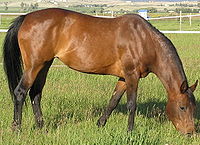
Equine coat color
Horses exhibit a diverse array of coat colors and distinctive markings. A specialized vocabulary has evolved to describe them.While most horses remain the same color throughout life, a few, over the course of several years, will develop a different coat color from that with which they were born...
of horse
Horse
The horse is one of two extant subspecies of Equus ferus, or the wild horse. It is a single-hooved mammal belonging to the taxonomic family Equidae. The horse has evolved over the past 45 to 55 million years from a small multi-toed creature into the large, single-toed animal of today...
s, characterized by a reddish brown body color with a black mane
Mane (horse)
The mane is the hair that grows from the top of the neck of a horse or other equine, reaching from the poll to the withers, and includes the forelock or foretop. It is thicker and coarser than the rest of the horse's coat, and naturally grows to roughly cover the neck...
, tail
Tail (horse)
The tail of the horse and other equines consists of two parts, the dock and the skirt. The dock consists of the muscles and skin covering the coccygeal vertebrae. The term "skirt" refers to the long hairs that fall below the dock...
, ear
Pinna
In animal anatomy, the pinna is the visible part of the ear that resides outside of the head ....
edges, and lower legs. Bay is one of the most common coat colors in many horse breeds.
The black areas of a bay horse's hair coat are called "black points", and without them, a horse cannot be a bay. Black points may sometimes be covered by white markings
Horse markings
Markings on horses usually are distinctive white areas on an otherwise dark base coat color. Most horses have some markings, and they help to identify the horse as a unique individual. Markings are present at birth and do not change over the course of the horse's life...
, however such markings do not alter a horse's classification as "bay". Bay horses have dark skin, except under white markings, where the skin is pink. Bay is genetically a base color and the addition of other genes creates many additional coat colors. While the basic concepts behind bay coloring are fairly simple, the genes themselves and the mechanisms that cause shade variations within the bay family are quite complex and, at times, disputed.
Color variations and terminology
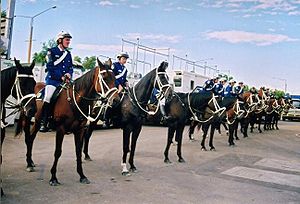
Chestnut (coat)
Chestnut is a hair coat color of horses consisting of a reddish-to-brown coat with a mane and tail the same or lighter in color than the coat. Genetically and visually, chestnut is characterized by the absolute absence of true black hairs...
, which is also a very dark brown color, but a liver chestnut has a brown mane, tail and legs; no black points.
The pigment in a bay horse's coat, regardless of shade, is rich and fully saturated. This makes bays particularly lustrous in the sun if properly cared for. Some bay horses exhibit dappling, which is caused by textured, concentric rings within the coat. Dapples on a bay horse suggest good condition and care, though many well-cared for horses never dapple. The tendency to dapple may also be, to some extent, genetic.
Bays often have a two-toned hair shaft, which, if shaved too closely (such as when body-clipping for a horse show
Horse show
A Horse show is a judged exhibition of horses and ponies. Many different horse breeds and equestrian disciplines hold competitions worldwide, from local to the international levels. Most horse shows run from one to three days, sometimes longer for major, all-breed events or national and...
), may cause the horse to appear several shades lighter, a somewhat dull orange-gold, almost like a dun. However, as the hair grows out, it will darken again to the proper shade. This phenomenon is part of bay color genetics, but usually not seen in darker shades of bay because there is less red in the hair shaft.
(See: "Inheritance and expression," below)

The palest shades, which lack specific English terminology found in other languages, are called wild bays. Wild bays are true bays with fully pigmented reddish coat color and black manes and tails, but the black points only extend up to the pastern
Pastern
The pastern is a part of the leg of a horse between the fetlock and the top of the hoof. It incorporates the long pastern bone and the short pastern bone , which are held together by two sets of paired ligaments to form the pastern joint...
or fetlock. Wild bay is often found in conjunction with a trait called "pangare" that produces pale color on the underbelly and soft areas, such as near the stifle and around the muzzle.
Bay horses have black skin and dark eyes, except for the skin under markings
Horse markings
Markings on horses usually are distinctive white areas on an otherwise dark base coat color. Most horses have some markings, and they help to identify the horse as a unique individual. Markings are present at birth and do not change over the course of the horse's life...
, which is pink. Skin color can help an observer distinguish between a bay horse with white markings and a horse which resembles bay but is not.
Ambiguity of "brown"
Some breed registries (including the Jockey Club ThoroughbredThoroughbred
The Thoroughbred is a horse breed best known for its use in horse racing. Although the word thoroughbred is sometimes used to refer to any breed of purebred horse, it technically refers only to the Thoroughbred breed...
registry) use the term "brown" to describe dark bays. However, "liver" chestnuts
Chestnut (coat)
Chestnut is a hair coat color of horses consisting of a reddish-to-brown coat with a mane and tail the same or lighter in color than the coat. Genetically and visually, chestnut is characterized by the absolute absence of true black hairs...
, horses with a red or brown mane and tail as well as a dark brownish body coat, are also sometimes called "brown" in some colloquial
Colloquialism
A colloquialism is a word or phrase that is common in everyday, unconstrained conversation rather than in formal speech, academic writing, or paralinguistics. Dictionaries often display colloquial words and phrases with the abbreviation colloq. as an identifier...
contexts. Therefore, "brown" can be an ambiguous term for describing horse coat color. It may be clearer to refer to dark-colored horses as dark bays or liver chestnuts. However, to further complicate matters, the genetics that lead to darker coat colors are also under study, including possible genes for sooty shading on any coat color, and the existence of a specific allele of Agouti linked to certain dark bays, called seal brown
Seal brown (horse)
Seal brown is a hair coat color of horses characterized by a near-black body color; with black points, the mane, tail and legs; but also reddish or tan areas around the eyes, muzzle, behind the elbow and in front of the stifle...
.
Effect of gray gene
Some foalFoal
A foal is an equine, particularly a horse, that is one year old or younger. More specific terms are colt for a male foal and filly for a female foal, but these terms are used until the horse is age three or four. When the foal is nursing from its dam , it may also be called a suckling...
s are born bay, but carry the dominant
Dominance relationship
Dominance in genetics is a relationship between two variant forms of a single gene, in which one allele masks the effect of the other in influencing some trait. In the simplest case, if a gene exists in two allelic forms , three combinations of alleles are possible: AA, AB, and BB...
gene for graying, and thus will turn gray
Gray (horse)
Gray or grey is a coat color of horses characterized by progressive silvering of the colored hairs of the coat. Most gray horses have black skin and dark eyes; unlike many depigmentation genes, gray does not affect skin or eye color Their adult hair coat is white, dappled, or white intermingled...
as they mature until eventually their hair coat is completely white. Foals that are going to become gray must have one parent that is gray. Some foals may be born with a few white hairs already visible around the eyes, muzzle, and other fine-haired, thin-skinned areas, but others may not show signs of graying until they are several months old.
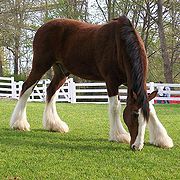 |
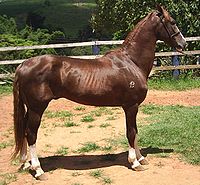 |
Colors confused with bay


- ChestnutsChestnut (coat)Chestnut is a hair coat color of horses consisting of a reddish-to-brown coat with a mane and tail the same or lighter in color than the coat. Genetically and visually, chestnut is characterized by the absolute absence of true black hairs...
, sometimes called "Sorrels," have a reddish body coat similar to a bay, but no black points. Their legs and ear edges are the same color as the rest of their body (unless they have white markings) and their manes and tails are the same shade as their body color or even a few shades lighter. - BlackBlack (horse)Black is a hair coat color of horses in which the entire hair coat is black. Black is a relatively uncommon coat color, and novices frequently mistake dark chestnuts or bays for black. However, some breeds of horses, such as the Friesian horse, Murgese and Ariegeois are almost exclusively black...
are occasionally confused with dark bays and liver chestnuts because some black horses "sunburn," that is, when kept out in the sun, they develop a bleached-out coat that looks brownish, particularly in the fine-haired areas around the flanks. However, a true black can be recognized by looking at the fine hairs around the muzzle and eyes. These hairs are always black on a black horse, but are reddish, brownish, or even a light gold on a bay or chestnut.
Bay-family colors
Bay is considered to be one of the "hard" or "base" coat colors in horses. The two others in this category are chestnutChestnut (coat)
Chestnut is a hair coat color of horses consisting of a reddish-to-brown coat with a mane and tail the same or lighter in color than the coat. Genetically and visually, chestnut is characterized by the absolute absence of true black hairs...
and black
Black (horse)
Black is a hair coat color of horses in which the entire hair coat is black. Black is a relatively uncommon coat color, and novices frequently mistake dark chestnuts or bays for black. However, some breeds of horses, such as the Friesian horse, Murgese and Ariegeois are almost exclusively black...
. The effects of additional equine coat color genes on a bay template alter the basic color into other shades or patterns:
- BuckskinBuckskin (color)Buckskin is a hair coat color of horses; referring to a color that resembles certain shades of tanned deerskin. Similar colors in some breeds of dogs are also called buckskin. The horse has a tan or gold colored coat with black points . Buckskin occurs as a result of the cream dilution gene acting...
horses have a black mane and tail, but instead of a red or brown coat, they have a cream or gold coat. Though once called a "Sandy" bay in older texts on horse color, the genetic distinction created by the cream geneCream geneThe cream gene is responsible for a number of horse coat colors. Horses that have the cream gene in addition to a base coat color that is chestnut will become palomino if they are heterozygous, having one copy of the cream gene, or cremello, if they are homozygous. Similarly, horses with a bay...
is significant. They are a bay horse that is also heterozygous for the dominant creme (CCr) allele. The black pigment remains largely unchanged, but any red pigment in the coat is diluted to gold. Buckskins are seldom mistaken for bays because their coats are significantly lighter and have no hint of a red or orange tint. - Perlinos are bay horses who are homozygous for the dominant creme (CCr) allele. Both black and red pigment are diluted to some shade of creme, though the formerly black points often have a stronger reddish cast. The skin is a slightly pigmented pink and the eyes are blue.
- Bay dunDun geneThe dun gene is a dilution gene that affects both red and black pigments in the coat color of a horse. The dun gene has the ability to affect the appearance of all black, bay, or chestnut -based horses to some degree by lightening the base body coat and suppressing the underlying base color to the...
s are bay horses with at least one dominantDominance relationshipDominance in genetics is a relationship between two variant forms of a single gene, in which one allele masks the effect of the other in influencing some trait. In the simplest case, if a gene exists in two allelic forms , three combinations of alleles are possible: AA, AB, and BB...
dun alleleAlleleAn allele is one of two or more forms of a gene or a genetic locus . "Allel" is an abbreviation of allelomorph. Sometimes, different alleles can result in different observable phenotypic traits, such as different pigmentation...
. Red and black pigment at the extremities remains largely unchanged, but on the body, black pigment is diluted to slate and red pigment is diluted to a dustier shade. The effect is similar to buckskin, but the coat of a bay dun is a flatter tan rather than bronze, and all duns have some form of primitive markingsPrimitive markingsPrimitive markings among domestic horses are a group of hair coat markings and qualities associated with primitive breeds, and the dun coat color family in particular. All dun horses possess at least the dorsal stripe but the presence of the other primitive markings varies...
that include a dorsal stripe along the backbone, and sometimes faint horizontal striping at the back of the front legs. - Amber champagneChampagne geneThe champagne gene is a simple dominant allele responsible for a number of rare horse coat colors. The most distinctive traits of horses with the champagne gene are the hazel eyes and pinkish, freckled skin, which are bright blue and bright pink at birth, respectively...
refers to a bay horse with at least one dominant champagne allele. Black pigment is diluted to warm brown and red pigment to gold. The effect is similar to buckskin, but the points of an amber champagne do not remain black, and the skin is mottled. Amber champagnes also have hazel eyes rather than brown. - Silver baySilver dapple geneThe silver dapple gene is a dilution gene that affects the black base coat color. It will typically dilute a black mane and tail to flaxen, and a black body to a shade of brown or chocolate. It is responsible for a group of coat colors in horses called "silver dapple" in the west, or "taffy" in...
s are bay horse with at least one dominant silver (Z) allele. Red pigment is unaffected, but black pigment in the short coat is diluted to dark, flat, brown-gray while the longer hairs are diluted to silver. The overall effect on a bay is that of a chocolate-colored horse with a pale mane and tail. - Bay RoanRoan (horse)Roan is a horse coat color pattern characterized by an even mixture of colored and white hairs on the body, while the head and "points"—lower legs, mane and tail—are more solid-colored. The roan pattern is dominantly-inherited, and is found in many horse breeds...
horses are bays with at least one dominant roan (Rn) allele. The roan gene creates an effect of white hairs intermingled with the red body coat. This color was formerly lumped together with chestnut or "strawberry" roans and called "red roan." - Bay pintoPinto horseA pinto horse has a coat color that consists of large patches of white and any other color. The distinction between "pinto" and "solid" can be tenuous, as so-called "solid" horses frequently have areas of white hair. Various cultures throughout history appear to have selectively bred for pinto...
s are bay horses with any number of white spotting genes, including but not limited to tobianoTobianoTobiano is a spotted color pattern commonly seen in Pinto horses, produced by a dominant gene. The tobiano gene produces white-haired, pink-skinned patches on a base coat color. The coloration is present from birth and does not change throughout the horse's lifetime, unless the horse also carries...
, frame overoOveroOvero refers to several genetically unrelated pinto coloration patterns of white-over-dark body markings in horses, and is a term used by the American Paint Horse Association to classify a set of pinto patterns that are not Tobiano...
or splashed whiteSplashed whiteSplashed white or splash is a horse coat color pattern that produces pink-skinned, white markings. Many splashed whites have very modest markings, while others have the distinctive "dipped in white paint" pattern. Blue eyes are a hallmark of the pattern, and splash may account for otherwise "solid"...
, and so on. The pattern has no bearing on whether or not the horse is bay.Pinto horsePinto horseA pinto horse has a coat color that consists of large patches of white and any other color. The distinction between "pinto" and "solid" can be tenuous, as so-called "solid" horses frequently have areas of white hair. Various cultures throughout history appear to have selectively bred for pinto...
s also may have a bay base coat overlaid by white spots. Sometimes the term SkewbaldSkewbaldSkewbald is a color pattern of horses. A skewbald horse has a coat made up of white patches on a non-black base coat, such as chestnut, bay, or any color besides black coat. Skewbald horses which are bay and white are sometimes called tricoloured...
or "Tricolor" is used, especially in the UK, to refer to bay pintos.- SabinoSabino horseSabino is a group of white spotting patterns in horses that affect the skin and hair. A wide variety of irregular color patterns are accepted as sabino. In the strictest sense, "sabino" refers to the white patterns produced by the Sabino 1 gene, for which there is a DNA test...
is a color pattern in the pinto family, but in some cases, the gene may be minimally expressed in the form of very bold white markingsHorse markingsMarkings on horses usually are distinctive white areas on an otherwise dark base coat color. Most horses have some markings, and they help to identify the horse as a unique individual. Markings are present at birth and do not change over the course of the horse's life...
or slight body spotting and such horses will be registered by their owners as "bay," particularly in breed registries that do not have a category for pinto.
- Sabino
- Bay LeopardLeopard complexThe leopard complex is a group of genetically-related coat patterns in horses. These patterns range from progressive increases in interspersed white hair similar to graying or roan to distinctive, Dalmatian-like leopard spots on a white coat. Secondary characteristics associated with the leopard...
s are horses that carry the leopard (Lp) gene or gene complex characteristic of the AppaloosaAppaloosaThe Appaloosa is a horse breed best known for its colorful leopard-spotted coat pattern. There is a wide range of body types within the breed, stemming from the influence of multiple breeds of horses throughout its history. Each horse's color pattern is genetically the result of various spotting...
and other breeds. This gene also produces secondary characteristics that include mottled skin, a white scleraScleraThe sclera , also known as the white or white of the eye, is the opaque , fibrous, protective, outer layer of the eye containing collagen and elastic fiber. In the development of the embryo, the sclera is derived from the neural crest...
around the eye, and striped hoovesHorse hoofA horse hoof is a structure surrounding the distal phalanx of the 3rd digit of each of the four limbs of Equus species, which is covered by complex soft tissue and keratinised structures...
. - A few bay horses may carry the rabicanoRabicanoRabicano, also called white ticking, is a horse coat color characterized by limited roaning in a specific pattern: interspersed white hairs most dense and originating from the flank and the tailhead...
gene, which either produces faint roaning on only some parts of the body or can cause some white or cream hairs to appear in the mane or tail, sometimes creating a "skunk" effect. Most bays with rabicano are registered as either bays or as bay roans.
Genetics
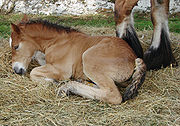
Chestnut (coat)
Chestnut is a hair coat color of horses consisting of a reddish-to-brown coat with a mane and tail the same or lighter in color than the coat. Genetically and visually, chestnut is characterized by the absolute absence of true black hairs...
horse, represented by the recessive
Recessive
In genetics, the term "recessive gene" refers to an allele that causes a phenotype that is only seen in a homozygous genotype and never in a heterozygous genotype. Every person has two copies of every gene on autosomal chromosomes, one from mother and one from father...
"e" allele; and black
Black (horse)
Black is a hair coat color of horses in which the entire hair coat is black. Black is a relatively uncommon coat color, and novices frequently mistake dark chestnuts or bays for black. However, some breeds of horses, such as the Friesian horse, Murgese and Ariegeois are almost exclusively black...
color, represented by the dominant "E" allele, are the two most basic coat color genes. All other colors are produced by the action of additional alleles acting on these two base colors.
A bay horse carries both the Extension
Melanocortin 1 receptor
The melanocortin 1 receptor , also known as melanocyte-stimulating hormone receptor , melanin-activating peptide receptor, or melanotropin receptor, is a G protein-coupled receptor which binds to a class of pituitary peptide hormones known as the melanocortins, of which include adrenocorticotropic...
(E) allele and a suppression gene known as the agouti gene
Agouti gene
The Agouti gene is responsible for determining whether a mammal's coat is banded or of a solid color . The chief product of the Agouti gene is Agouti signalling peptide , but there are a number of alternative splice products....
(A).The agouti gene, dominant over the black gene, limits or suppresses the black coloring to black points, allowing the underlying red coat color to come through. Unlike other types of "point"
Point (coat color)
Point coloration refers to animal coat coloration with a pale body and relatively darker extremities, i.e. the face, ears, feet, tail, and scrotum...
coloring, such as that seen in Siamese cats, the black points characteristic of bay coloring are not produced by a dilution
Dilution gene
Dilution gene is a popular term for any one of a number of genes that act to create a lighter coat color in living creatures. There are many examples of such genes:-General:...
or albinism
Albinism
Albinism is a congenital disorder characterized by the complete or partial absence of pigment in the skin, hair and eyes due to absence or defect of an enzyme involved in the production of melanin...
gene
Gene
A gene is a molecular unit of heredity of a living organism. It is a name given to some stretches of DNA and RNA that code for a type of protein or for an RNA chain that has a function in the organism. Living beings depend on genes, as they specify all proteins and functional RNA chains...
.
Because the extension (E) gene and agouti (A) gene can be either heterozygous or homozygous, the extent to which a bay passes on its color varies widely from one horse to another depending on its genotype and that of its mate. Also, a chestnut may carry the Agouti gene, which will be "masked" or not manifest until the horse is bred to a horse with the E allele and produces offspring with both genes.
Inheritance and expression

Gene
A gene is a molecular unit of heredity of a living organism. It is a name given to some stretches of DNA and RNA that code for a type of protein or for an RNA chain that has a function in the organism. Living beings depend on genes, as they specify all proteins and functional RNA chains...
s: Extension
Melanocortin 1 receptor
The melanocortin 1 receptor , also known as melanocyte-stimulating hormone receptor , melanin-activating peptide receptor, or melanotropin receptor, is a G protein-coupled receptor which binds to a class of pituitary peptide hormones known as the melanocortins, of which include adrenocorticotropic...
and Agouti
Agouti signalling peptide
Agouti signalling peptide, a product of the Agouti gene, is a peptide consisting of 131 amino acids. Its discovery was published in 1994 in the scientific journal Nature where its functional properties were described...
. The role of the Extension gene is to produce a protein
Protein
Proteins are biochemical compounds consisting of one or more polypeptides typically folded into a globular or fibrous form, facilitating a biological function. A polypeptide is a single linear polymer chain of amino acids bonded together by peptide bonds between the carboxyl and amino groups of...
called Melanocortin 1 receptor
Melanocortin 1 receptor
The melanocortin 1 receptor , also known as melanocyte-stimulating hormone receptor , melanin-activating peptide receptor, or melanotropin receptor, is a G protein-coupled receptor which binds to a class of pituitary peptide hormones known as the melanocortins, of which include adrenocorticotropic...
or Mc1r. Mc1r allows the black pigment eumelanin to form in hair. Closely tied to this process, the role of the Agouti gene is to produce Agouti signalling peptide
Agouti signalling peptide
Agouti signalling peptide, a product of the Agouti gene, is a peptide consisting of 131 amino acids. Its discovery was published in 1994 in the scientific journal Nature where its functional properties were described...
Asip, which disables Mc1r, effectively allowing the red pigment phaeomelanin to "show through." However, this disabling does not occur throughout the coat; it occurs only in pulses on the body coat and not at all on the extremities or points.
If a horse does not possess a functional, dominant copy of the wildtype E-allele
Allele
An allele is one of two or more forms of a gene or a genetic locus . "Allel" is an abbreviation of allelomorph. Sometimes, different alleles can result in different observable phenotypic traits, such as different pigmentation...
at the Extension locus
Locus (genetics)
In the fields of genetics and genetic computation, a locus is the specific location of a gene or DNA sequence on a chromosome. A variant of the DNA sequence at a given locus is called an allele. The ordered list of loci known for a particular genome is called a genetic map...
, then Mc1r cannot be produced. Without this protein, the black pigment eumelanin cannot form in the hair. Such horses, having two copies of the recessive mutation, have eumelanin-free, phaeomelanin-rich coats; they are red, or chestnut
Chestnut (coat)
Chestnut is a hair coat color of horses consisting of a reddish-to-brown coat with a mane and tail the same or lighter in color than the coat. Genetically and visually, chestnut is characterized by the absolute absence of true black hairs...
. In summary, unless a horse has at least one functional E-allele, it cannot be bay.
Similarly, if a horse does not possess a functional, dominant copy of the A-allele at the Agouti locus, then Asip cannot be produced. Without Asip, eumelanin is unreglated and the coat is wholly black. The regulation of black pigment, though, is dependent on its presence in the first place; a horse with the recessive Agouti genotype aa is indistinguishable from any other genotype in a horse with a eumelanin-free coat. When eumelanin is present, it is restricted in varying degrees by the action of Asip.
The action of Asip can be observed in horses which have their winter coats clipped. When shaved close, the black tip is shorn off leaving the phaeomelanic bottom of the shaft. This produces a dull, orange-gold appearance on the body coat which is lost with the spring shed. This is not usually seen in dark bays, which have little red in the hair shaft.
Agouti
The cause behind the various shades of bay, particularly the genetic factors responsible for wild bay and seal brownSeal brown (horse)
Seal brown is a hair coat color of horses characterized by a near-black body color; with black points, the mane, tail and legs; but also reddish or tan areas around the eyes, muzzle, behind the elbow and in front of the stifle...
, have been contested for over 50 years. In 1951, zoologist Miguel Odriozola published "A los colores del caballo" in which he suggested four possible alleles for the "A" gene. He described an order of dominance between the alleles and the associated phenotypes:
- a, the least dominant, must be homozygous to be observed and is responsible for unrestricted black coat (non-agouti black),
- At, only visible in the homozygous form or when paired with a, is responsible for the black-and-tan seal brown coat,
- A, visible when homozygous or when paired with a or At, is responsible for the standard bay coat,
- A+, dominant, is responsible for the wildtype wild bay coat.
This was accepted until the 1990s, when a new theory became popular. The new theory suggested that shades of bay were caused by many different genes, some which lightened the coat, some which darkened it. This theory also suggested that seal brown horses were black horses with a trait called pangare. Pangare is an ancestral trait also called "mealy", which outlines the soft or communicative parts of the horse in buff tan.
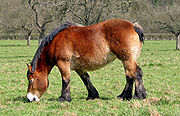
Since 2001, the mechanisms of the variations within the "bay" category remain unclear. Ongoing research suggests that Odriozola's theories may have been correct, evidenced by a parallel condition in mice. Mice have more than six alleles at the Agouti locus, including At which produces black-and-tan.
It is still likely that to some extent, the "shade" of coat color may be regulated by unrelated genes for traits like "sooty
Sooty (coat)
Sooty is a term used to describe certain shades of horse coat color. Horses with the sooty trait have black or darker hairs mixed into their coats, typically concentrated along the top of the horse and less prevalent on the underparts...
", and that the phenotypes of sooty or dark bays/browns may overlap.
See also
- Equine coat color geneticsEquine coat color geneticsEquine coat color genetics determine a horse's coat color. There are many different coat colors possible, but all colors are produced by the action of only a few different genes. The simplest genetic default color of all domesticated horses can be described as either "red" or "non-red", depending...
- Equine coat colorEquine coat colorHorses exhibit a diverse array of coat colors and distinctive markings. A specialized vocabulary has evolved to describe them.While most horses remain the same color throughout life, a few, over the course of several years, will develop a different coat color from that with which they were born...

